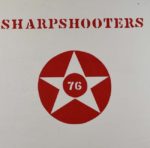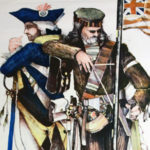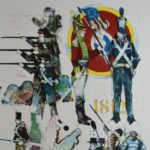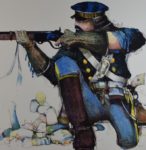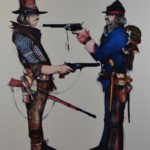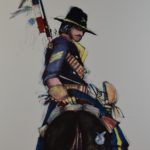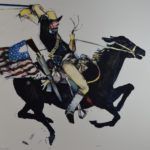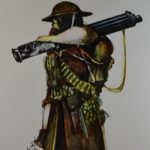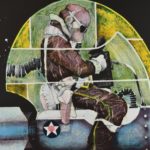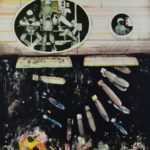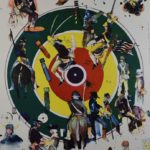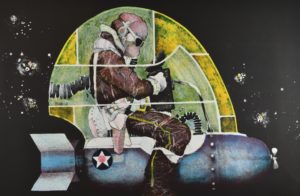
DU1980.4, John L. Doyle (1939-2010)
Exhibition Dates: Feb. 1 to May 12, 2017
by Grace Martin ’18
John Lawrence Doyle (1939-2010) was a Chicago-born artist with a fascination in the human condition. He studied ethnology and anthropology, and his accuracy in details is evident in all of his art.
Directly after the end of the tragic Vietnam war and in anticipation of the U.S. Bicentennial in 1976, Doyle created a series of lithographs we are excited to exhibit in the Denison Museum. On display are the eleven vibrant prints of Sharpshooters 76; a series presenting soldiers from wars of America’s past.
Beginning chronologically, The Continentals shows two weary soldiers with red-stained hands lean on each other during the revolutionary war. Next comes the War of 1812, where paper-doll soldiers fall in a storybook format. Eventually the series enters the Civil War. Two soldiers stand face to face with bloodstained hands, representing the two halves of the divided country. The print serves as a reminder that the country we live in today has not remained so without cost. Brother against brother, nearly 625,000 soldiers died in the Civil War- more than half of the total number of American soldiers who have died in all U.S. wars. Further, although the Union won the war and slavery was abolished, prejudice against former slaves did not end. Interestingly, though, Doyle represents no African-Americans as a part of his visual narrative. Civil Warriors is not the only print in the series where certain groups of people are left out. In fact, in nearly every print we view the war from only one point of view.
Later in the series comes Sony War. The viewer is placed in front of a television set which shows American troops dropping bombs on Vietnam. The Vietnam War, or the “Television War,” was the first televised war in history. In the print, the visualization of the falling bombs substitutes colorful firework-like explosions for the destruction of the Vietnamese landscape and people below. Perhaps Doyle’s image explores how televising war idealizes, desensitizes, and alters the way war is viewed– the reality of the horror and violence of war is mediated to present it as entertaining and beautiful.
In some prints, we look through the lens of cultural myths to heroize one particular group of people while making others invisible. As we reflect on the exhibit, we might consider how the soldiers are represented and who seems to be left out (victims, other soldiers, ect…). In a way, these lithographs are asking us to reflect deeply on the ways we visualize warfare and violence. How have we chosen to tell our history?
This exhibit, “The Art of War: John Lawrence Doyle’s Sharpshooters 76” is on display in the Denison Museum and has been featured in the Columbus Dispatch.
Exhibition curated by Grace Martin ’18, Curatorial Intern.
- DU1980.1b
- DU1980.11 John L. Doyle Mid to late 20th century United States Lithograph Gift of Gary I. Katz Revolutionary War (1775-1783)
- DU1980.6 John L. Doyle (1939-2010) Mid to late 20th century United States Lithograph Gift of Gary I. Katz War of 1812 (1812-1815)
- DU1980.9 John L. Doyle (1939-2010) Mid to late 20th century United States Lithograph Gift of Gary I. Katz Mexican American War (1846-1848)
- DU1980.8 John L. Doyle (1939-2010) Mid to late 20th century United States Lithograph Gift of Gary I. Katz Civil War (1861-1865)
- DU1980.7 John L. Doyle (1939-2010) Mid to late 20th century United States Lithograph Gift of Gary I. Katz Indian Wars (c.1870-1890)
- DU1980.5 John L. Doyle (1939-2010) Mid to late 20th century United States Lithograph Gift of Gary I. Katz Spanish-American War (April 1898-August 1898)
- DU1980.3 John L. Doyle (1939-2010) Mid to late 20th century United States Lithograph Gift of Gary I. Katz World War I (1914-1918)
- DU1980.4 John L. Doyle (1939-2010) Mid to late 20th century United States Lithograph Gift of Gary I. Katz World War II (1939-1945)
- DU1980.1a John L. Doyle (1939-2010) Mid to late 20th century United States Lithograph Gift of Gary I. Katz Korean War (1950-1953)
- DU1980.2 John L. Doyle (1939-2010) Mid to late 20th century United States Lithograph Gift of Gary I. Katz Vietnam War (1954-1975)
- DU1980.10 John L. Doyle (1939-2019) Mid to late 20th century United States Lithograph Gift of Gary I. Katz

